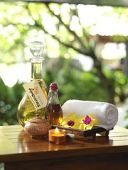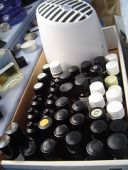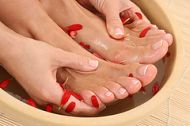Aromatherapy Techniques

Essential oils are rarely used in their original, concentrated form but are always taken into the body via a carrier substance. This can be anything which takes the oils into the body: air, water, vegetable oils, lotions and creams are all carriers.

1.Inhalation:
When we breathe in the fragrance of an essential oil, some of its molecules travel to the lungs, pass through the lining and into the bloodstream, where they travel around the body. Other molecules take an upward route to the brain, which recieves a healing message – to relax or energize, for example – and transmits the appropriate signal along the nerve channels of the body. Inhalation is the quickest way for oils to enter the body, and is the most effective way to deal with fragile emotions, and negative states of mind such as stress and depression. It is very useful for respiratory conditions, especially those that may present an emergency situation such as bronchitis or asthma. Although essential oils maybe inhaled directly from the bottle, other methods are preferred.
The Hands: This method is useful for emergencies. Put one drop of essential oil into your palm and rub your hands briefly together. Now cup your hands over your nose, avoiding the eye area, and take a deep breath.
A Tissue: Place a few drops of essential oil onto a tissue and take three deep breaths. The tissue can then be placed on your pillow or inside your shirt, so that you will continue to benefit from the oil’s aroma.
Steam Inhalation: Fill a basin with hot water and ahh no more than 2-3 drops ( use 1-2 drops for children and the elderly) of essential oil. Keeping your eyes closed to protect them from the powerful vapours, lower your head over the bowl and breathe in deeply.
A Vaporiser: This is one of the most popular methods of all for oil inhalation. Electric vaporisers are available, and are the safest types to use. Night-light vaporisers (or oil burners) are inexpensive and readily available in different sizes and designs. The base model involves a night-light candle standing under a tiny cup filled with water, to which a few drops of oil are added. Keep the vaporiser out of reach of children and pets. Top up the water and add more oils as necessary. Use a vaporiser to keep infections at bay, to relax after a stressful day, or to set the mood for a party or a romantic evening. The number of oil drops is not critical and really depends on the size of the room.
Safety: The quantities of essential oils given above for inhalations are suitable for children and the elderly unless stated otherwise.

2.Bathing:
Essential oils do not dissolve well in water, and it is important that the molecules are evenly distributed. Bathing can enhance the effects of essential oils: the oils are not only absorbed through the skin but their aroma is also inhaled. There are several ways to enjoy bathing with essential oils.
Bath: Run the water in the bath to a comfortable temperature. Next, add 6-8 drops of oil, then swish the water thoroughly to disperse the oil. Sit in the bath, and for maximum benefit, stay in the water for at least ten minutes to allow the oil to penetrate your skin and to enjoy the benefits of its aroma. If you prefer, the oils can be mixed with 15ml / 1 tbsp dairy cream or honey before being added to the bath. This will help to disperse the oils. Alternatively, you can mix the oils into powdered milk, adding water to make a paste, before adding the mixture to the bath water. Bath oil prepared from vegetable oil and mixed with essential oils is fine for dry skin, but will feel greasy on normal skins.

Foot And Hand Bath: For sprains, localized swelling, bruising, or similar discomforts, ten minutes in a foot or hand bath containing 6-8 drops of your chosen oils will bring welcome relief. Remember to keep a kettle of warm water nearby to add to the water in the bowl before it cools too much for comfort.
Sitz-Bath: For vaginal thrush, a sitz-bath with essential oils is an effective treatment. Fill a large bowl one-third full with warm water and add 3-4 drops of your chosen oil. Sit in the bath for ten minutes.
Showers: It is not as easy to benefit from essential oils in the shower. However, you can add some oils to your shower gel or put some onto a sponge. Rub this over your body in the shower, or before you get into it. Make the most of this aroma, breathing deeply and rubbing with your sponge or hands while slowly rinsing. If you wash off the oils too quickly, you won’t feel the benefit. Finish with a body lotion mixed with an oil.
Safety: For children and the elderly the essential oil quantities should be halved.